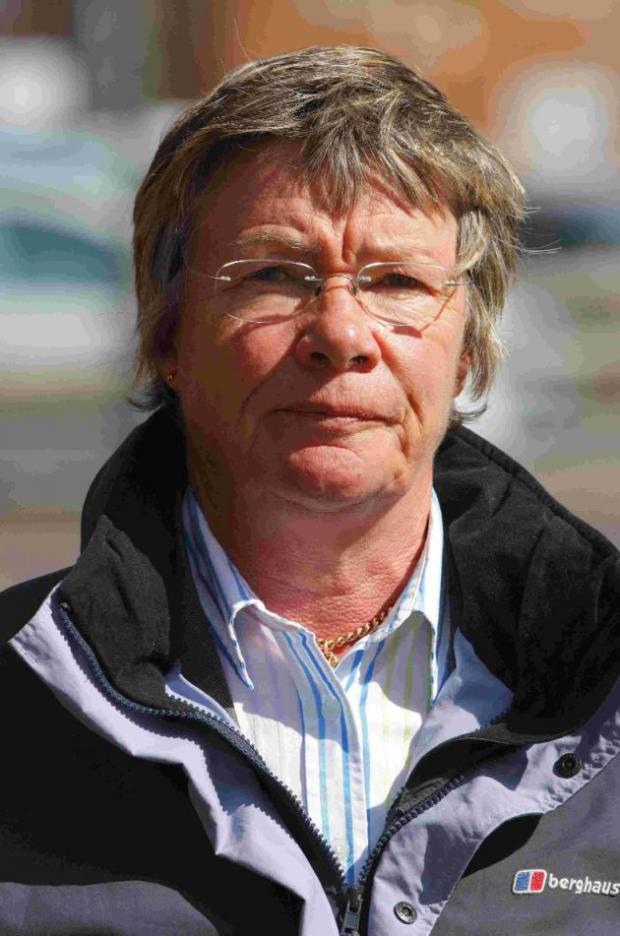 Healthcare professional: "...a ‘haunted and harrowed’ expression on her face showed she was dying."
Healthcare professional: "...a ‘haunted and harrowed’ expression on her face showed she was dying."The GSF Prognostic Indicator Guidance
Three triggers that suggest that patients are nearing the end of life are:
1. The Surprise Question: ‘Would you be surprised if this patient were to die in the next few months, weeks, days’?
2. General indicators of decline - deterioration, increasing need or choice for no further active care.
3. Specific clinical indicators related to certain conditions.
This is The News -
Dr Barton saw a change in Mrs Richards.
She said: ‘There was a marked deterioration, she was dying.
‘She was being unresponsive, she was not eating or drinking.
‘She had a haunted, harrowed expression.
‘She just wasn’t just frail, she was dying.’
On August 18, it was decided Mrs Richards would be given diamorphine.
Dr Barton told the court the syringe driver was ‘not the act of promoting or hastening death’ or the ‘instrument of death’.
Mrs Richards died on August 21, the cause of death was put down to bronchopneumonia.
Dr Barton said the use of the syringe driver did not impact this.
The inquest continues.
This is the LCP!
Bring them all to heel and put them in the dock. They are all Jane Bartons.
Four years ago, the Southern Daily Echo reported -
Gosport War Memorial Hospital known as ''end of the line''
3:45pm Monday 20th April 2009 in Health
GOSPORT War Memorial Hospital became known as the ''end of the line'' and as ''death ward'' as families saw their loved ones checked in apparently on the road to recovery only to die a few days later.
But despite a series of police investigations and NHS probes, none of the staff on Dryad and Daedalus wards at the hospital, then run by the now non-existent Portsmouth Healthcare NHS Trust, have been disciplined or charged with a criminal offence.
The month-long inquest held by Portsmouth and South East Hampshire Deputy Coroner Andrew Bradley heard one bereaved relative after another speak of their shock at the rapid deterioration of their loved ones after they entered the GWMH.They believed their elderly relatives were given excessive doses of painkillers such as diamorphine which unnecessarily hastened their deaths.
Robert Wilson, 74, was admitted to Dryad ward in October 1998 after he suffered a broken arm.
He also suffered from liver problems because of a long-standing drink problem.
His son Iain Wilson told the inquest his father had made a good recovery at the Queen Alexandra Hospital in Portsmouth from the fall that broke his arm.
But when he was transferred to GWMH, his condition deteriorated severely and he died four days later.
Mr Wilson said: ''I went to give him a cuddle and he spoke his last words to me: 'Help me son, they are killing me.'
''I said 'No they are not Dad, they are trying to do the best for you' and I left him there.
''When I went in the following day, he was in a coma.''
Mr Wilson said staff would not explain why his father was being given diamorphine.
Mr Wilson said: ''I think it is because of the drugs that his condition changed.''
Professor Richard Baker, of the University of Leicester's department of health and science, examined the case and said that Mr Wilson might have left the hospital alive if he had not been put on diamorphine.
The cause of death given at the time was heart and liver failure.
In a statement read to the hearing, Prof Baker said: ''The initiation of the diamorphine was inappropriate and the starting dose too high.
''Mr Wilson might have left the hospital alive if he had not been started on diamorphine.''
Brian Cunningham, 79, was admitted to Dryad ward in September 1998 with serious bed sores and was given diamorphine when he became agitated. He died five days later.
His step-son Charles Farthing told the inquest the ward was known as ''death ward'' and that he believed his step-father had been ''intentionally executed''.
Professor David Black, an independent specialist in elderly care, said the dose increases in the last two days of Mr Cunningham's life were ''excessive''.
He told the inquest: ''There is no justification given for these in the notes.
''It is not clear if this was a medical or nursing decision.''
Mr Cunningham died on 26 September, 1998. The cause of death on his death certificate was pneumonia.
The inquest has also heard that two other patients were apparently treated for the wrong medical problem while at the hospital.
Geoffrey Packman, 66, was being treated in September 1999 for a heart condition but staff failed to spot that he was also suffering from internal bleeding.
Professor Andrew Wilcock, an expert in palliative care, told the inquest he was also given ''excessive amounts'' of diamorphine and he died nine days after arriving on Dryad ward. The cause of death on his death certificate was a heart attack.
Elsie Lavender, 83, was admitted to Daedalus ward after suffering a stroke in 1996 but she had actually broken her neck, the inquest heard.
Prof Black told the hearing her paralysis appeared to have been caused by the injury rather than a stroke.
The hearing was told that she became weaker and weaker and died the day after being given an increased dose of diamorphine.
Her son, Alan Lavender, said that he had asked Dr Jane Barton when his mother would be able to return home as they had to make arrangements concerning her cat.
He said that Dr Barton had replied: ''You can get rid of the cat. Do you know your mother has come here to die?''
Mr Lavender said: ''I was shocked at the way this was said to me. I did not know that to be the case. I thought she had gone into the hospital for rehabilitation.
''I couldn't believe the cold way the news had been broken to me, as if it was pre-determined. I was shocked.''
However Dr Barton, who was the main doctor in charge of the two wards, said that many relatives had ''unrealistic expectations'' for the health of their loved ones as they arrived at GWMH.
She said that patients were often sent from other hospitals with the word ''rehabilitation'' on their medical notes when in reality they were terminal cases.
Dr Barton, who was the only member of staff to be investigated in relation to the deaths at the hospital but who never faced any charges, also said that increasing numbers of seriously-ill patients were being sent to GWMH.
She said that this was because of a bed-blocking crisis at other hospitals in the area.
The inquest heard that Dr Barton was a GP who worked part-time at GWMH for about 90 minutes a day on weekdays only, looking after 40 patients.
She said that the pressure caused by the greater number of patients with serious conditions led to her medical notes becoming ''sparse''.
The inquest heard that she also introduced a system of pre-emptive prescribing which allowed nurses to increase the amount of painkillers such as diamorphine without the need of a doctor being present.
She said that she raised the issue of increased workload with the Trust but there was no-one else to help her and she eventually quit in April 2000.
She told her bosses that the growing number of seriously-ill patients being admitted would ''lead to further serious and damaging complaints about the service given in my wards''.
Nurse Lynne Barrett told the inquest that most of the patients who came to the hospital were terminal cases and were ''patients that nobody wanted''.
Disgrace, disgrace, disgrace... "She said that patients were often sent from other hospitals with the word ''rehabilitation'' on their medical notes when in reality they were terminal cases."My dear mum went into hospital for rehabilitation. Is this what happened to her...? How many Jane Bartons are there out there?
Bring them all to heel and put them in the dock. They are all Jane Bartons!
Four years later, the Southern Daily
Echo reports -
 Dr Jane Barton.
Dr Jane Barton.
The Southern Daily Echo reports -
Doctors clash at inquest over pensioner's morphine dosage
10:33am Thursday 11th April 2013 in News By Emma Streatfield, Senior Reporter
By Emma Streatfield, Senior Reporter
 By Emma Streatfield, Senior Reporter
By Emma Streatfield, Senior Reporter Dr Jane Barton.
Dr Jane Barton.
TWO doctors have clashed over whether the correct pain relief drugs were given to a Hampshire pensioner who died in hospital.
Gladys Richards, 91, passed away at Gosport War Memorial Hospital 15 years ago having been admitted to recover from a broken hip.
An inquest heard how Mrs Richards had been given a more powerful form of morphine.
One expert witness said it had been appropriate while another said it had a role in speeding up her death.
Mrs Richards, who lived at a Lee-on-the-Solent nursing home, died on August 21 1998 while under the care of Dr Jane Barton.
The hearing into Mrs Richards’ death follows an inquest in 2009 that recorded verdicts that drugs had been a factor in the deaths of five other patients at Gosport War Memorial Hospital.
Her daughter, Gillian MacKenzie, has campaigned tirelessly to get an inquest into her mother’s death.
The Southern Daily Echo reports -

"Mrs Mackenzie, of Eastbourne, East Sussex, has told the hearing that the hospital's medical staff placed her mother on a course of palliative care which ''condemned'' her mother to death."

The News
BBC News Hampshire & Isle of Wight reports -
15 April 2013 Last updated at 15:05
Gosport hospital death: Gladys Richards 'had look of dying woman'
A doctor has told an inquest that she could tell her patient was dying by the expression on her face.
Jane Barton was speaking in the case of Gladys Richards who died at Gosport War Memorial Hospital (GWMH) in 1998.
The 91-year-old was sent there to recover from a hip operation but died after being given diamorphine.
Her family has accused the hospital of "condemning" Mrs Richards to death, but Dr Barton said she was trying to relieve her suffering.
Inquests into 10 other deaths at the hospital in 2009 found that drugs were a contributory factor in some cases.
Hampshire Constabulary investigated the deaths of 92 elderly patients at GWMH but no prosecutions have ever been brought.
The inquest has heard Mrs Richards' family thought she was going to the hospital for two to four weeks to recover from a hip operation after a fall.
'Haunted, harrowed expression'
Dr Barton said it was likely Mrs Richards may already have been dying and that her chances were 50/50.
Mrs Richards subsequently suffered another fall, was transferred hospitals and had additional surgery.
Those factors reduced her chances of survival, Dr Barton said.
She told the coroner she could tell she was dying by looking at her.

No comments:
Post a Comment